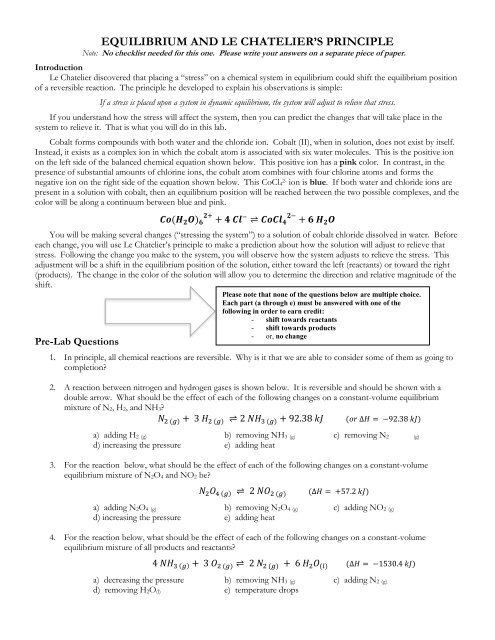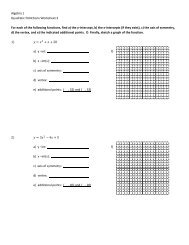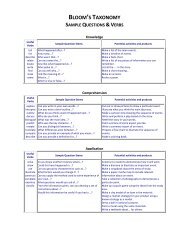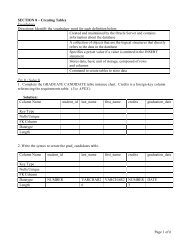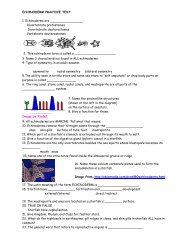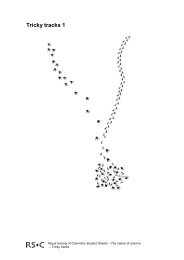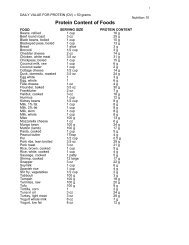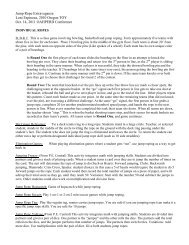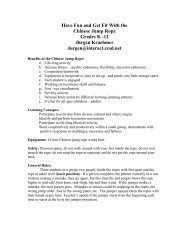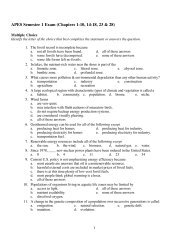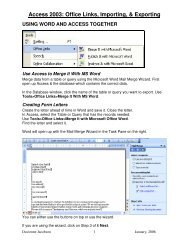EQUILIBRIUM AND LE CHATELIER’S PRINCIPLE
Equilibrium and Le Chatelier's Principle Lab
Equilibrium and Le Chatelier's Principle Lab
- No tags were found...
Create successful ePaper yourself
Turn your PDF publications into a flip-book with our unique Google optimized e-Paper software.
<strong>EQUILIBRIUM</strong> <strong>AND</strong> <strong>LE</strong> <strong>CHATELIER’S</strong> PRINCIP<strong>LE</strong>Note: No checklist needed for this one. Please write your answers on a separate piece of paper.IntroductionLe Chatelier discovered that placing a “stress” on a chemical system in equilibrium could shift the equilibrium positionof a reversible reaction. The principle he developed to explain his observations is simple:If a stress is placed upon a system in dynamic equilibrium, the system will adjust to relieve that stress.If you understand how the stress will affect the system, then you can predict the changes that will take place in thesystem to relieve it. That is what you will do in this lab.Cobalt forms compounds with both water and the chloride ion. Cobalt (II), when in solution, does not exist by itself.Instead, it exists as a complex ion in which the cobalt atom is associated with six water molecules. This is the positive ionon the left side of the balanced chemical equation shown below. This positive ion has a pink color. In contrast, in thepresence of substantial amounts of chlorine ions, the cobalt atom combines with four chlorine atoms and forms thenegative ion on the right side of the equation shown below. This CoCl 42- ion is blue. If both water and chloride ions arepresent in a solution with cobalt, then an equilibrium position will be reached between the two possible complexes, and thecolor will be along a continuum between blue and pink.You will be making several changes (“stressing the system”) to a solution of cobalt chloride dissolved in water. Beforeeach change, you will use Le Chatelier’s principle to make a prediction about how the solution will adjust to relieve thatstress. Following the change you make to the system, you will observe how the system adjusts to relieve the stress. Thisadjustment will be a shift in the equilibrium position of the solution, either toward the left (reactants) or toward the right(products). The change in the color of the solution will allow you to determine the direction and relative magnitude of theshift.Pre-Lab QuestionsPlease note that none of the questions below are multiple choice.Each part (a through e) must be answered with one of thefollowing in order to earn credit:- shift towards reactants- shift towards products- or, no change1. In principle, all chemical reactions are reversible. Why is it that we are able to consider some of them as going tocompletion?2. A reaction between nitrogen and hydrogen gases is shown below. It is reversible and should be shown with adouble arrow. What should be the effect of each of the following changes on a constant-volume equilibriummixture of N 2, H 2, and NH 3?a) adding H 2 (g) b) removing NH 3 (g) c) removing N 2 (g)d) increasing the pressure e) adding heat3. For the reaction below, what should be the effect of each of the following changes on a constant-volumeequilibrium mixture of N 2O 4 and NO 2 be?a) adding N 2O 4 (g) b) removing N 2O 4 (g) c) adding NO 2 (g)d) increasing the pressure e) adding heat4. For the reaction below, what should be the effect of each of the following changes on a constant-volumeequilibrium mixture of all products and reactants?a) decreasing the pressure b) removing NH 3 (g) c) adding N 2 (g)d) removing H 2O (l) e) temperature drops
5. The reaction provided in the introduction yields an equilibrium mixture of a pink compound and a bluecompound. Rewrite the balanced chemical equation and label the reactant and product side as either pink or blueaccording the information in the introduction. (This will be helpful to know for the lab analysis.)ProcedureSAFETY - 6.0 M HCl is corrosive, will cause burns and can permanently damage your eyes. Avoid skin contactwhen working with cobalt chloride crystals and solutions. Avoid inhalation of cobalt chloride.1) Select 3 clean and dry test tubes of the same size and label them tubes 1, 2, and 3.2) To each test tube add approximately 0.20 g of cobalt chloride crystals. (Use weight boats to mass each sample.)3) Do the following: To Tubes 1 and 3 add 1.0 ml of distilled water and stir.(This will become pink – reactants predominate, the Co(H 2O) 62+ ion is in abundance). To Tube 2 add 1.0 ml of 6.0 M HCl and stir.(This will become blue – products predominate, the CoCl 42-ion is in abundance). Tubes 1 & 2 will be the standards that you use to estimate the equilibrium position for the solution in Tube 3.4) Predict what happens (will it become more pink, more blue, or not change) if you add 5 ml of 6M HCl to Tube 3.5) Add 5 ml of 6 M HCl to Tube 3. Record the color change that occurs (if any).6) If we assign the color in Tube 1 to be a “1”, and the color in Tube 2 to be a “10”, indicate a number between 1 and 10that corresponds to the color currently in Tube 3.Note: This is a scale between pink and blue, NOT a scale of lightness or darkness.7) Predict what happens (will it become more pink, more blue, or not change) if you add 5 ml of distilled water to Tube 3.Check point: AFTER you write your prediction, but BEFORE you try it out obtain Mr. Kanter’s initials:8) Add 5 ml of distilled water to Tube 3. Record the color change that occurs (if any).9) Using the same scale from step 6, indicate a number between 1 & 10 that corresponds to the color currently in Tube 3.________________________MR. KANTER’S INITIALS10) Predict what happens (will it become more pink, more blue, or not change) if the equilibrium solution is heated.11) Fill a 400-ml beaker with 300 ml of tap water. Place Tube 3 into the water in the beaker and heat the beaker of waterwith a Bunsen burner until the water boils. Turn off the burner. Record what happens with the color in Tube 3.12) Using the same scale from step 6, indicate a number between 1 & 10 that corresponds to the color currently in Tube 3.13) Infer from your observations whether the reaction is endothermic or exothermic.14) Predict how the solution in Tube 3 will respond to being immersed in 0 ° C water.15) Record what happens with the color in Tube 3 when it is placed and cooled within an ice bath at 0 ° C.16) Dispose of all test tube waste in the provided waste beaker.17) Clean all of your glassware in the sink and let these materials air dry on the counter.Post-Lab Questions6. In three cases during this lab, you made a prediction about how the equilibrium position of a solution would shiftas a result of a stress placed on it. Explain each of these predictions.7. If your prediction was incorrect in any of these cases, explain what actually took place and why.8. Based on your data, was heat energy a reactant or a product in this reaction? Explain your reasoning.9. For each of the four steps performed on Tube 3(add HCl, add H 2O, add heat, remove heat), explain yourobservations using LeChatelier’s Principle.


